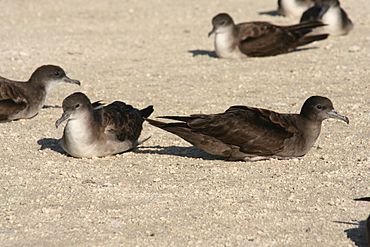Capricornia Cays National Park facts for kids
Quick facts for kids Capricornia Cays National ParkQueensland |
|
|---|---|
|
IUCN Category II (National Park)
|
|

The Capricornia Cays support a breeding population of over half a million breeding pairs of wedge-tailed shearwaters
|
|
| Established | 1994 |
| Area | 1.78 km2 (0.7 sq mi) |
| Managing authorities | Queensland Parks and Wildlife Service |
| Website | Capricornia Cays National Park |
| See also | Protected areas of Queensland |
The Capricornia Cays National Park is a special protected area in Queensland, Australia. It's made up of 241 hectares (about 600 acres) of small coral islands called 'cays'. These cays are located off the coast, north of Brisbane.
People love visiting this park for many fun activities. You can enjoy watching birds, whales, and turtles. It's also a great place for camping, walking, swimming, boating, snorkelling, and diving. The park is famous for its amazing variety of plants and animals. It's also a safe home for many endangered species. The Capricornia Cays are especially important because they have the largest group of endangered loggerhead turtles breeding in the South Pacific.
You can reach these beautiful islands by boat from Gladstone, Bundaberg, and 1770.
Amazing Birds of the Cays
The Capricornia Cays are a very important place for birds. They are known as an Important Bird Area. This is because they are home to huge numbers of certain bird species.
For example, more than 1% of the world's population of black noddies live here. There can be up to 300,000 nests! Also, up to 560,000 nests of wedge-tailed shearwaters can be found. This means most of these birds that breed in eastern Australia live here. Sometimes, more than 1% of the world's brown boobies (1,000-4,000 nests) also make their home here.
To protect these breeding seabirds, some areas of the park are closed during certain times of the year.
The Coral Cays
The Capricornia Cays National Park protects eight coral islands. These islands are part of the Capricorn and Bunker group. They are located in the southern part of the Great Barrier Reef. These islands are:
- Erskine Island
- Heron Island (eastern half)
- Lady Musgrave Island - This island is open for visitors. Up to 40 campers can stay here.
- Masthead Island - This island is also open for visitors. It can hold 60 campers. However, from October to March, only 30 campers are allowed. This helps protect the turtles when they lay their eggs.
- North West Island - This island is open for visitors and can host up to 150 campers.
- Tryon Island - This island is currently closed to visitors. This is because of a tree infection. It used to have space for 30 campers.
- Wilson Island
These islands are completely made from corals. The surrounding waters are also important for fishing, especially for king prawns. All eight of these islands are part of the Great Barrier Reef World Heritage Area. They are all surrounded by beautiful coral reefs. The main type of tree growing on these cays is the Pisonia grandis.
There are also six other cays that form the Capricornia Cays National Park (Scientific). These are:
- One Tree Island
- Wreck Island
- Fairfax Islands (East Fairfax & West Fairfax)
- Hoskyn Islands (East and West Hoskyn islands)
The public is not allowed to visit these six scientific cays. They are kept undisturbed for research and protection.
About the Scientific National Park
The scientific part of the Capricornia Cays National Park is very important for research.
- Area: It covers 0.44 square kilometres.
- Coordinates: 23°20′07″S 151°57′24″E / 23.33528°S 151.95667°E
- Managed by: The Queensland Parks and Wildlife Service looks after this area.
- IUCN category: This park is in Category Ia. This means it's a "Strict Nature Reserve." These areas are protected for scientific research and environmental monitoring.
See also
 In Spanish: Parque nacional Cayos Capricornia para niños
In Spanish: Parque nacional Cayos Capricornia para niños


